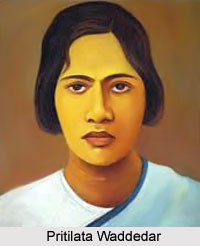 Pritilata Waddedar, also known as Preetilata Waddedar, was an Indian freedom fighter and a revolutionary who is renowned for her significant contributions in the Indian freedom struggle. Waddedar was a member of the armed resistance movement, which was led by Masterda Surya Sen. Pritilata Waddedar was amongst the prime members of the Indian Republican Army. It was a revolutionary group in Chittagong which included several Indian revolutionaries and Indian freedom fighters who conducted and participated in the well known Chittagong Armoury Raid Case in the year 1930.
Pritilata Waddedar, also known as Preetilata Waddedar, was an Indian freedom fighter and a revolutionary who is renowned for her significant contributions in the Indian freedom struggle. Waddedar was a member of the armed resistance movement, which was led by Masterda Surya Sen. Pritilata Waddedar was amongst the prime members of the Indian Republican Army. It was a revolutionary group in Chittagong which included several Indian revolutionaries and Indian freedom fighters who conducted and participated in the well known Chittagong Armoury Raid Case in the year 1930.
Early Life of Pritilata Waddedar
Pritilata Waddedar was born on 5 May 1911 in Chittagong, which was a part of British India at the time. She studied at the Dr. Khastagir Government Girls` School of Chittagong and successfully passed her matriculation examination in 1st division in the year 1928. Later she got admitted to the Eden College in Dhaka and in the year Pritilata passed the Intermediate examinations in the 5th place amongst all the applicants from Dhaka Board.
Eventually she graduated in Philosophy with distinction from Bethune College of Calcutta (now Kolkata). But her degree was withheld by the British authorities at the University of Calcutta. After 80 years the degree was conferred to her after her death. During her education in college, she was much inspired by a freedom fighter named Ramkrishna Biswas, who was hanged later. She received various forms of combat training from Nirmal Sen.
Revolutionary Activities of Pritilata Waddedar
Pritilata Waddedar became a member of the Indian Republican Army during the early 1930s. The Indian Republican Army was a revolutionary group of Chittagong that was led by Surya Sen. The group conducted the Chittagong Armoury Raid in the year 1930. The armoury raid in Chittagong was perhaps the most surprising and valiant revolutionary endeavours in the history of the Indian freedom struggle that was devised by the youths of the region. The attack was conducted on 18th April 1930 to raid the armoury of police and auxiliary forces from the Chittagong in Bengal province during the rule of the British Empire in India. The Indian Republican Army was led by Masterda Surya Sen and other prominent members included Anand Gupta, Jiban Ghoshal, Ananta Singh, Tarakeswar Dastidar, Ambika Chakrobarty, Subodh Roy, Harigopal Bal (Tegra), Ardhendu Dastidar, Sasanka Datta, Kalpana Dutta, Pritilata Waddedar, Naresh Roy, Nirmal Sen, Lokenath Bal and Ganesh Ghosh.
Surya Sen devised a plan to attack the Pahartali European Club in the year 1932. Pritilata was entrusted by Sen with leading a team of around 10 to 12 members to attack the Club on 23 September 1932. The different members of the team were instructed to take potassium cyanide with them so that they could swallow it in case they were caught by the British police. Although the raid was successful but Pritilata Waddedar, who was disguised as a man, got trapped and she committed suicide by swallowing the potassium cyanide. This concluded her efforts in securing the freedom of the nation from the rule of the British Empire in India.



















